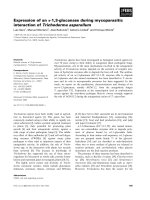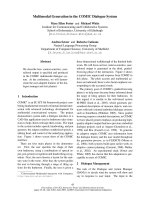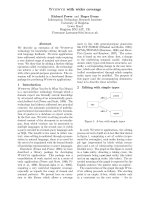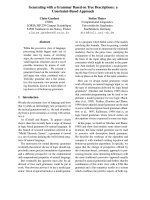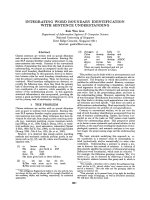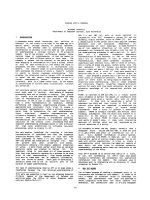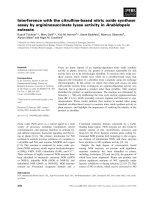Báo cáo khoa học: "EXPERIENCES WITH AN ON-LINE TRANSLATING DIALOGUE SYSTEM" docx
Bạn đang xem bản rút gọn của tài liệu. Xem và tải ngay bản đầy đủ của tài liệu tại đây (646.07 KB, 8 trang )
EXPERIENCES WITH AN ON-LINE TRANSLATING
DIALOGUE SYSTEM
Seiji MHKE, Koichi HASEBE, Harold SOMERS , Shin-ya AMANO
Research and Development Center
Toshiba Corporation
1, Komukai Toshiba-cho, Saiwai-ku
Kawasaki-City, Kanagawa, 210 Japan
ABSTRACT
An English-Japanese bi-directional machine
translation system was connected to a keyboard
conversation function on a workstation, and tested
via a satellite link with users in Japan and
Switzerland. The set-up is described, and some
informal observations on the nature of the bilin-
gual dialogues reported.
INTRODUCTION
We have been developing an English-Japanese
bi-directional machine translation system imple-
mented on a workstation (Amano 1986, Amano
et
a/. 1987). The system, which is interactive and
designed for use by a translator, normally runs in
an interactive mode, and includes a number of spe-
cial bilingual editing functions. We recently real-
ized a real-time on-line communication system
with an automatic translation function by combin-
ing a non-imeractive version of our Machine Trans-
lation system with the keyboard conversation func-
tion just like
talk
in UNIX**. Using this system,
bilingual conversations were held between mem-
bers of our laboratory in Japan and visitors to the
5th World Telecommunications Exhibition
Tele-
corn 87,
organized by the International Telecom-
munication Union, held in Geneva from 20th to
27th October 1987.
In the fh-st part of this paper, we discuss in
detail the configuration of this system, and give
some indications of its performance. In the second
part, we report informally on what for us was an
interesting aspect of the experiment, namely the
nature of the dialogues held using the system. In
*the Centre for Computational Linguistics,
University of Manchester Institute of Science and
Technology, England
**UNIX is a trademark of AT&T Bell Labora-
tories.
particular we were struck by the amount of meta-
dialogue, i.e. dialogue discussing the previous
interchanges: since contributions to the conversa-
tion were being translated, this metadialogue
posed certain problems which we think are of gen-
eral interest. In future systems of a similar
nature, we feel there is a need for users to be
briefly trained in certain conventions regarding
metadialogue, and typical system translation
errors. Furthermore, an environment which mini-
mizes such errors is desirable and the system must
be 'tuned' to make translations appropriate to con-
versation.
SYSTEM CONFIGURATION
A general idea of the system is illustrated in
Figure 1. Workstations were situated in Japan and
Switzerland, and linked by a conventional satel-
lite telephone connection. The workstations at
either end were AS3260C machines. Running
UNIX, they support the Toshiba Machine Transla-
tion system AS-TRANSAC. On this occasion, the
Machine Translation capability was installed only
at the Japanese end, though in practice both termi-
nals could run AS-TRANSAC.
The workstation screens are divided into three
windows, as shown in Figure 2, not unlike in the
normal version of UNIX's
talk. The
top window
shows the user's dialogue, the middle window the
correspondenfs replies. The important difference
is that both sides of the dialogue are displayed in
the language appropriate to the location of the ter-
minal. However, in a third small window, a
workspace at the bottom of the screen, the raw
input is also displayed. (This access to the English
input at the Japanese end is significant in the case
of Japanese users having some knowledge of
English, and of course
vice versa if
appropriate.)
The bottom window also served the purpose of
indicating to the users that their conversation part-
ners were transmitting.
155
OIALOGUE
USING
KEYOOARO$
svalze~
Figure 1. General Set-up
tel lo, Takeda. My name is suzanne.
[ live in geneva, but I come froe California.
/es, ~t ~hen
I
~as 12 ~ars old.
/ery interesting, Quick, and useful !
~ov many languages do you spaak, Takeda ?
rhet is ok.
]
=- __'L., :_._-'- II
MY name is Takeda.
Please tell me your name.
Where do YOU live?
]see.
Have you visited Japan?
Please tell me the impression of this machir
Thank you.
I
can speak only Japanese.
IS [l[liil~ : SUZLHIII,C't,~qVI
I1 Ill=ill Iil]lll',,,i~ilBI g IIIl~i]
Switzerland
/~-, Tal<eclao ~o)~l~l:s u zanne~o
~v,, b~,b/~'~J 2~'~'~o
~o
k~1"o
That
is ok,
Figure 2. Screen Display
Japan
156
Figure 3 shows the set-up in more detail. At
the Japanese end, the user inputs Japanese at the
keyboard, which is displayed in the upper window
of the workstation screen. The input is passed to
the translation system and the English output,
along with the original input is then transmitted
via telecommunications links (KDD's Venus-P and
the Swiss PTT's Telepac in this case) to Switzer-
land. There it is processed by the keyboard conver-
sation function, which displays the original input
in the workspace at the bottom of the screen, and
the translated message in the middle window on
the screen. The set-up at the Swiss end is similar
to that at the Japanese end, with the important
exception that only the original input message is
transmitted, since the translation will take place
at the receiving end.
TRANSLATION METHOD
An input sentence is translated by morphologi-
cal
analyzer,
dictionary
look-up module, parser,
semantic analyzer, and target sentence generator.
Introducing a full-fledged semantic analyzer con-
flicts with avoiding increases in processing time
and memory use. To resolve this conflict, a Lexi-
cal Transition Network Grammar (LTNG) has
been developed for this system.
LTNG provides a semantic framework for an
MT system, at the same time satisfying processing
time and memory requirements. Its main role is to
separate parsing from semantic analysis, i.e., to
make these processes independent of each other. In
LTNG, parsing includes no semantic analysis. Any
ambiguities in an input sentence remain in the syn-
tactic structure of the sentence until processed by
the semantic analyzer. Semantic analysis proceeds
according to a lexical grammar consisting of rules
for converting syntactic structures into semantic
structures. These rules are specific to words in a
pre-eompiled lexicon. The lexicon consists of one
hundred thousand entries for both English and
Japanese.
SYSTEM PERFORMANCE
Once the connection has been established, con-
versation proceeds as in UNIX's talk. An impor-
tant feature of the function is that conversers do
not have to take turns or wait for each other to
finish typing before replying, unlike with write.
This has a significant effect on conversational
strategy, and occasionally leads to disjointed con-
versations, both in monolingual and bilingual dia-
logues. For example, a user might start to reply
to a message the content of which can be predicted
after the first few words are typed in; or one user
might start to change the topic of conversation
while the other is still typing a reply.
Transmission of input via the satellite was gen-
erally fast enough not to be a problem: the real
bottle-neck was the physical act of input. Novice
users do not attain high speed or accuracy, a prob-
lem exacerbated at the Swiss end by a slow screen
echo. But the problem is even greater for Japanese
input: users typed either in romaji (i.e. using a
standard transcription
into
the Roman alphabet)
or in hiragana (i.e. using Japanese-syllable values
for the keys). In either case, conversion into kanji
(Chinese characters) is necessary (see Kawada et
al. 1979 and Mori et al. 1983 on kana.to-kanji
conversion); and this conversion is needed for
between a third and a half of the input, on average
(el. Hayashi 1982:211). Because of the large hum-
AS 3260C
E2
conversation I
_~ function
El.,,
r2.,E2
PTT
Telep~
"J2,E2
KDD E2
Venus-P Jr
3260C
\
I conversation
function
translation
system
Switzerland
Figure 3. Configuration
Japan
157
ber of homophones in Japanese, this can slow
down the speed of input considerably. For exam-
ple, even for professional typists, an input speed
of 100 characters (including conversions) per
minute is considered reasonable (compare expected
speeds of up to 100 words/minute for English typ-
ing). It is of interest to note that this kana-to-
kanji conversion, which is accepted as a normal
part of Japanese word-processor usage, is in fact a
natural form of pre-editing, given that it serves as
a partial disambiguation of the input.
On the other hand, slow typing speeds are also
encountered for English input, one side-effect of
which is the use of abbreviations and shorthand.
In fact, we did not encounter this phenomenon in
Geneva, though in practice sessions (with native
English speakers) in Japan, this had been quite
common. Examples included contractions (e.g.
pls for please,.u for you, cn for can), omis-
sions of apostrophes (e.g. cant, wont, dont)
and non-capitalization (e.g. i, tokyo, jal).
The translation time itself did not cause signif-
icant delays compared to the input time, thanks to
a very fast parsing algorithm, which is described
elsewhere (Nogami et al. 1988). Input sentences
were typically rather short (English five to ten
words, Japanese around 20 characters), and transla-
tion was generally about 0.7 seconds per word
(5000 words/hour). Given users' typing speed and
the knowledge that the dialogue was being trans-
mitted half way around the world, what would,
under other circumstances, be an unacceptably long
delay of about 15 seconds (for translation and
transmission) was generally quite tolerable,
because users could observe in the third window
that the correspondent was inputting something,
even if it could not read.
TRANSLATION QUALITY
This environment was a good practical test of
our Machine Translation system, given that many
of the users had little or no knowledge of the tar-
get language: the effectiveness of the translation
could be judged by the extent to which communi-
cation was possible. Having said this, it should
also be remarked that the Japanese-English half of
the bilingual translation system is still in the
experimental stage and so translations in this
direction were not always of a quality comparable
to those in the other direction. To offset this, the
users at the Japanese end, who were mainly
researchers at our laboratory and therefore famil-
iar with some of the problems of Machine Transla-
tion, generally tried to avoid using difficult con-
structions, and tried to 'assist' the system in some
other ways, notably by including subject and
object pronouns which might otherwise have been
omitted in more natural language.
We recognized that the translation of certain
phrases in the context of a dialogue might be dif-
ferent
from their translation under normal circum-
stances. For example, Engfish I see should be
translated as naruhodo rather than watashi ga
miru, Japanese wakarimashita should be I under-
stand rather than I have understood, and so on.
Nevertheless, the variety of such conversational
fillers is so wide that we inevitably could not
foresee them all.
The English-Japanese translation was of a high
quality, except of course where the users - being
inexperienced and often non-native speakers of
English - n~de typing mistakes, e.g. (I). (In
these and subsequent examples, E: indicates
English input, J: Japanese input, and T: transla-
tion. Translations into Japanese are not shown.
Typing errors and mistranslations are of course
reproduced from the original transmission.)
(la) E: this moming i came fro st. galle
to
vizite the
exosition.
E: it is vwery inyteresti ng to see so
many apparates here.
(lb) E:
(lc) E:
J:
J:
I arderd "today's menu'.
i would go tolike a girl.
b~
9
"~-¢A,o
T: I don't understand.
t
o 1 i k e ~j:fSJ'C"~';~o
T: What is
tolike?
These were sometimes compounded by the
delay in screen echo of input characters, as in
example (2).
(2)
E: Sometimes, I chanteh the topic,
suddenly.
E:
I
change teh topic.
J: ~ ~ ~o
T:I understand.
E: I had many mistakes.
J: ~b ~ ~: I¢~-C v-,'£ ~o
T: Are you tired?
E: A
little.
E: But the main reason is the delay
fo
dispaying.
E: But the main reason is the delay of
display.
158
Failure to identify proper names or acronyms
often led to errors (by the system) or misunder-
standings (by the correspondent), as in (3a), espe-
cially when the form not to be translated happens
to be identical to a known word, as in (3b). In
(3b),
'go men na sai'
means in Japanese that I'm
sorry.
(3a) E: lars engvall.
J: 1at s engva 1 lhtfaJ"
"O3'-~0
T: What is
lars engvall?
E: this is my name.
(3b)
[having been asked if he knows
Japanese]
E: How about go men na sai?
T: &'©,,t: 5 Ir__Ic 9 v-,-C~ <_
Jk_n a_ s a i.
This was avoided on the Japanese-English side
where proper names were typed in
romaji
(4).
(4) J: ~I,©~ ~I~N o g a m i "C'"J-o
T: My name is
Nogami.
As with any system, there were a number of
occasions when the translation was too literal,
though even these were often successfully under-
stood (5).
(5) E:
J:
Do you want something to drink?
~o
T: Yes.
E: What drink do you want?
J: ~w=
e
~JJC~.3.h: w,
T: I want to drink a warm coffee.
E: warm coffee?
E: Not a hot one?
J: ,,~, v, =
e
'e3"o
T:
It is a
hot coffee.
One problem was that the system must always
give some output, even when it cannot analyse the
input correcdy: in this environment failure
to
give some result is simply unacceptable. Howev-
er, this is difficult when the input contains an
unknown word, especially when the source lan-
guage is Japanese and the unknown word is trans-
mitted as a
kanji.
Our
example (6) nevertheless
shows how a cooperative user will make the most
of the output. Here, the non-translation of
tsuki
mae (fi] ~ ) is compounded by its mis-translation
as a prepositional object. The first Japanese sen-
tence said that I married two months ago. But the
English correspondent imagines the untranslated
kanji
might mean 'wives'!
(6)
J: ~/,t-J:27J ~ E~ L too
T: I married to 2 ~ ~-~].
E: are married to 2 what???.
J: ~-~©6~ tc~
l.fco
T: I married in this year June.
E: now i understand.
E: i thought you married 2 women.
In the reverse direction, the problem is less
acute, since most Japanese users can at least read
Roman
characters,
even if they do not understand
them
(7):
this led in this case
to an
interesting
metadialogue. Again, the English user was cooper-
ative, and rephrased what he wanted
to
say in a
way that the system could translate correcdy.
(7) E: can you give me a crash course in
japanese?.
J: c r a s h c o u r s e~f~'O~
~o
T: What is crash course?
E: it means learn much in a very short
time.
Mistransladons were a major source of metadi-
alogue, to be discussed below, though see particu-
larly example (10).
THE NATURE OF THE DIALOGUES
There has been some interesting research recent-
ly (at ATR in Osaka) into the nature of keyboard
dialogues (Arita
et aL
1987; Iida 1987) mainly
aimed at comparing telephone and keyboard conver-
sions. They have concluded that keyboard has the
same fundamental conversational features as tele-
phone conversation, notwithstanding the differ-
ences between written and spoken language. No
mention is made of what we are calling here meta-
dialogue, though it should be remembered that our
dialogues are quite different from those reported
by the ATR researchers in that we had a transla-
tion system as an intermediary. No comparable
experiment is known to us, so it is difficult to
find a yardstick against which to assess our find-
ings.
Regarding the subject matter of our dialogues,
this was of a very general nature, often about the
local situation (time, weather), the dialogue part-
ner (name, marital status, interests) or about
recent news. A lot of the dialogue actually con-
cemed the system itself, or the conversation. An
159
obvious example of this would be a request to
rephrase in the case of mistranslation, as we have
seen in (6) above, though not all users seemed to
understand the necessity of this tactic (8).
(8) E: how does your sistem work please.
J: ~.L~ ~: ©~©,~b~ r) ~-'~-A,o
T: I don't understand a meaning
of the sentence.
E: how does your sistem work?
Often, a user would seek clarification of a mis-
or un-translated word as in
(9),
or (3) above.
(9) E: I could have riz in the dinner.
J: r
i z ~7 ~
:/:~-@~o
T: Is riz French?
E: May be. I'm not sure.
J: ~-(" 3",~o
T:
Is it rice?
E: In my guess, you are right.
J:
~ ~'9"o
T: It is natural.
E: What is natural?
T: I understand French.
J: r i z ~:~'C~o
T: Riz is
rice.
The most interesting metadialogues however
occurred when users failed to distinguish cited
words - a problem linguists are familiar with -
for example by quotation
marks:
these
would then
be re-translated, sometimes leading to further
confusion (10).
0o)
Jl: B~:©Ep~'~L."C < ~ Wo
T:
Please speak a Japanese
impression.
E1 : ichibana.
J2: b~ ~ ",~ ~-A,o
J3: i c h i b a n a ~1~'~';~o
T:What is ichibana?
E2: i thought it means number one.
J4:
f~ ~ ~:'(-~o
T:What is the first?
E3: the translation to you was
incorrect.
This example may need explanation. First the
translation of the Japanese question (J1) has been
misunderstood: the translation should have been
'Please give me your impressions of Japan', but the
English user (E-user) has understood
Japanese
to
mean 'Japanese language'. That is, E-user has under-
stood J1 to be saying 'Please speak an impressive
Japanese word.' Then E-user confused ichiban
('number 1' or 'the first') and ikebana ('flower
arranging'). The word
ichibana
(El) does not
exist in Japanese. His explanation 'number one'
was correctly translated (not shown here) as
ichiban. But not realizing of course that the mean-
ing of his first sentence (J1) was incorrectly
understood, the Japanese user (J-user) could not
understand E1 (J2) and asked for its sense (J3).
So E-user tried to explain the meaning of
/¢h/bana, which in fact was ichiban. By the
answer, J-user has identified what E-user ment,
but since J-user still did not realized that his first
sentence was incorrectly understood and hence J-
user has understood E2 to be saying that some-
thing was 'number 1', he tried to ask what was
'number 1' (J4).
But in the translation of this question,
ichiban
( ~ ) was translated as 'the fLrsf. At this point,
it is not clear which comment E-user is referring
to in E3, but anyway, not realizing what answer
J-user have expected and not knowing enough
Japanese to realize what has happened - i.e. the
connection between 'number one' and 'the firsf - E-
user gives up and changes the subject. If E-user
had intended to speak ikebana and explained its
meaning, J-user could have realized J1 had been
misunderstood. Because it is meaningless
in a sen-
tence
saying someone's impression that something
is ikebana.
On the other hand, where the user knew a lit-
de of the foreign language (typically the Japanese
user knowing English rather than vice versa), such
a misunderstanding could be quickly dealt with
(11).
(11) E: How is the weathere in Tokyo?
J:we a
t
h e r e i'~we a
t
h e r
T: Is weathere weather?
CONCLUSIONS
There are a number of things to be learnt from
this experiment, even if it was not in fact set up
to elicit information of this kind. Clearly, typing
errors are a huge source of problems, so an envi-
ronment which minimizes these is highly desir-
able. Two obvious features of such an environment
are fast screen echo, and delete and back-space keys
which work in a predictable manner in relation to
what is seen on the screen. For the correction of
typing errors, the system should have a spelling-
160
check function which works word-by-word as
users are typing in. The main reasons for syntax
errors are ellipsis and unknown words. Therefore,
the system should have a rapid syntax-check func-
tion which can work before transmission or trans-
lation and can indicate to users that there is a syn-
tax error so that users can edit the input sentence
or reenter the correct sentence. These are in them-
selves not new ideas, of course (e.g. Kay 1980 and
others).
Conventions for citing forms not to be trans-
law, d,
especially
in metadialogue, must
be devel-
oped, and the Machine Translation system must be
sensitive to these. The system must be 'tuned' in
other ways to make translations appropriate to
conversation, in particular in the translation of
conversational fillers like I see and wakarimashita.
Finally, it seems to be desirable that users be
trained briefly, not only to learn these conven-
tions, but also so that they understand the limits
of the system, and the kind of errors that get pro-
duced, especially since these are rather different
from the errors occasionally produced by human
translators or people conversing in a foreign lan-
guage that they know only partially.
REFERENCES
AMANO Shin-ya, Hiroyasu NOGAMI &
Seiji MIIXE (1988). A Step towards Telecommu-
nication with Machine Interpreter. Second Interna-
tional Conference on Theoretical and Methodologi-
cal Issues in Machine Translation of Natural Lan-
guages, June 12-14, 1988 (CMU).
NOGAMI Hiroyasu, Yumiko YOSHIMU-
RA & Shin-ya AMANO (1988). Parsing with
look-ahead in a real time on-line translation sys-
tem. TO be appeared in COLING 88, Budapest.
AMANO shin-ya, Kimihito TAKEDA,
Koichi HASEBE & Hideki HIRAKAWA (1988).
Experiment of Automatic Translation Typing
Phone (in Japanese). Information Processing Soci-
ety of Japan (1988.3.16-18)
TAKEDA Kimihito, Koichi HASEBE & Shin-
ya AMANO (1988). System Configuration of
Automatic Translation Typing Phone (in
Japanese). Information Processing Society of Japan
(1988.3.16-18)
ASAHIOKA Yoshimi, Yumiko
YOSHIMU-
RA, Seiji MIIKE & Hiroyasu NOGAMI (1988).
Analysis of the Translated Dialogue by Automatic
Translation Typing Phone (in Japanese). Informa-
tion Processing Society of Japan (1988.3.16-18)
ARITA Hidekazu, Kiyoshi KOGURE, Izum
NOGAITO, Hiroyuki MAEDA & Hitoshi IIDA
(1987). Media-dependent conversation manners:
Comparison of telephone and keyboard conversa-
tions (in Japanese). Information Processing Soci-
ety of Japan 87-M (1987.5.22)
IIDA Hitoshi (1987). Distinctive features
of conversations and inter-keyboard interpreta-
tion. Workshop on Natural Language Dialogue
Interpretation, November 27-28, 1987, Advanced
Telecommunications Research Institute (ATR),
Osaka.
AMANO Shin-ya (1986). The Toshiba
Machine Translation system. Japan Computer
Quarterly 64 "Machine Translation - Threat or
Tool" (Japan Information Processing Development
Center, Tokyo), 32-35.
AMANO Shin-ya, Hideki HIRAKAWA &
Yoshinao TSUTSUMI (1987). TAURAS: The
Toshiba Machine Translation system. MT Machine
Translation Summit, Manuscripts & Program,
Tokyo: Japan Electronic Industry Development
Association (JEIDA), 15-23.
KAY Martin (1980). The proper place of
men and machines in language translation. Report
CSL-80-11, Xerox-PARC, Palo Alto, CA.
HAYASHI Ooki (kanshuu) (1982). ~ ~k: (~
1982).
~lH~r~.
KAWADA Tsutomu, Shin-ya AMANO,
Ken-ichi MORI & Koji KODAMA (1979).
Japanese word processor JW-10. Compcon 79
(Nineteenth IEEE Computer Society International
Conference, Washington DC), 238-242.
MORI Ken-ichi, Tsutomu KAWADA &
Shin-ya AMANO (1983). Japanese word proces-
sor. In T. KITAGAWA (Ed.) Japan Annual
Reviews in Electronics, Computers & Telecommu-
nications Volume 7: Computer Sciences & Tech-
nologies, Tokyo: Ohmsha, 119-128.
APPENDIX A.
Overall Performance Data
sessions 78 times
utterances 1429 times (100%)
18.3 time/session
utterances that were
successfully translated 1289 times (90%)
utterances that were
mis-translated 140 times (10%)
metadialogues 31 times
0.4 time/session
161
APPENDIX B.
Subject Matter in Utterances
total utterances
greeting and self introduction
response signals
about weather
about time
others
1429 times (100%)
470 times (33%)
154 times (11%)
92 times (6%)
56 times (4%)
657 times (46%)
APPENDIX C.
Type of Expressions in Metadialogue
total metadialogues 31 times
repetition of a part of partner's
utterances (e.g. What is ichibana?) 22 times
(English users' are 2 and Japanese users' are 20)
telling typing errors or mistranslations
(e.g. Error in Translation.) 9 times
(English users' are 6 and Japanese users' are 3)
APPENDIX D. Distribution of Utterances
(ia), (lb), (2) and so on are corresponding to examples in the text. Those
numbers are put in the area in which main utterances in the examples are involved.
::,, i!iiiiiiiiiiiiiiiiiiiiiiiiiiiiiiiiiiii!iiiiiiiiiiiiiiiiiiiiiill iiiiiiiii!iiii
®
: total 1429 utterances
I'
: 1289 utterances that were successfully translated
: 140 utterances that were mis-~ranslated
: 31 utterances that caused metadialogues
A: by typing errors (7times)
B: by mistranslations (5times)
C: by unknown words to the partner and so on (19times)
162
